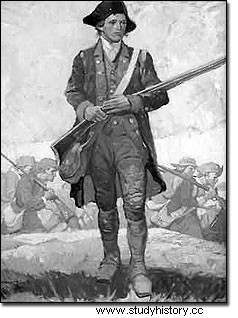
Minutemen is the name given to members of the Thirteen Colonies militia who swore to be ready for battle within two minutes.
This term has since been used to refer to other United States military units, referring to the success and patriotism of the original minutemen. Today it is mainly used to designate paramilitary militias targeting illegal immigrants and particularly active on the border with Mexico1,2,3.
History
As early as 1645, within the Massachusetts Bay Colony, a few men were selected from local troops to be ready for rapid deployment. Minutemen were usually chosen from among the settlers of the same town, so it was not uncommon for them to fight alongside cousins or brothers-in-law.
Some towns in Massachusetts organized part of their militia very early on to become minutemen, while others preferred to keep theirs in a single unit. After the Powder Alarm in late 1774, patriotic leaders in the newly formed Massachusetts Congress recommended that all militias include companies of minutemen (special units whose members would receive additional training, standing ready for action in the event of an emergency). emergency), only a few cities followed this recommendation.
The minutemen were most often under 25 and were selected for their enthusiasm, reliability and strength. They were the first armed force to join the battlefield or stand ready for any conflict. Officers were elected by their men and each unit drafted a convention which had to be signed upon enlistment. As a rule, they gathered for training four times a year, in times of peace. It was not uncommon to see officers, in the middle of a battle, consulting their men about a decision to be made, instead of issuing orders that should be followed without discussion.
Motivation
The mode of municipal decision-making and the colonial legislative body in New England meant that these men had already had the experience of self-government for several generations. Although most of them were unable to express their strong feelings for human rights and government goals, they knew that the professional British army, which had once fought alongside them in the face of a common enemy, was this time on their lands in order to deprive them of their freedoms. A Massachusetts man used the phrase "An Englishman's home is his castle" when he explained to his friends why he had barricaded himself in his home, to fight the British army as it unfolded. often during the final stages of the Battle of Lexington and Concord. The typical American patriot from Massachusetts was fighting for a political idea even in the very first moments of the war, when the desire for independence from Great Britain was not yet a feeling shared by all.
Equipment, training and tactics
Most colonial militias did not provide weapons or uniforms, so the men had to equip themselves. Many of them simply wore their farm or work clothes, others had hunting clothes made of buckskin. Some even adorn themselves with Indian attributes, going so far as to put war paint on their faces, in order to intimidate the enemy. The majority of minutemen used shotguns, which lacked bayonets, but were accurate at long ranges.
The regular continental army subsequently received European-style military training, unlike the militias. Minutemen were not used in the classic online battles of the time, but rather as foot hunters or snipers, roles in which they proved to be much more effective.
Their experience made them suitable for guerrilla warfare, most of them being hunters on the frontier. The Indian wars and more particularly the Franco-Indian War had taught men and officers the importance of guerrilla warfare, whereas the British troops, freshly arrived from Europe, were totally foreign to it. The wild lands that extend outside the colonial villages, very familiar to the minutemen, also favor this type of combat.
The musket used by the minutemen also lent itself well to their battle tactics, the helical grooving of the bore of the barrel giving it greater accuracy of fire. On the other hand, the loading of this weapon being longer and the firing frequency decreased, this type of rifle was not used by the regular infantry but rather for hunting. In their role as skirmishers, the minutemen fired and took cover (or retreated sharply behind other troops) before the British soldiers could take aim. The better accuracy and longer range of this type of rifles, added to their experience as hunters which made them snipers, gave the minutemen a dismal reputation.
As ammunition and provisions were scarce and constantly seized by British patrols, they were, as a precaution, often hidden by the minutemen in fields or wooded areas but also hidden under the floors of houses and barns.
Inheritance
On the occasion of the commemoration of the centenary of the first victorious resistance to British forces, Daniel Chester French created one of his most famous statues (along with that of the Lincoln Memorial), the Concord minuteman. On the base of the statue is the stanza of the Hymn of Concord written by Ralph Waldo Emerson in 1837 "Shot heard 'round the world". The statue depicts Isaac Davis, captain of the militia from the town of Acton, Massachusetts, the first to be killed in action in Concord during the Battle of Lexington and Concord on April 19, 1775.
A portable medal commemorating the bicentenary of the "minuteman" exists. It depicts a minuteman armed with a rifle, the 13 stars of the States of origin, the reverse is blank. The ribbon is made up of 3 equal stripes, blue/white/red.
